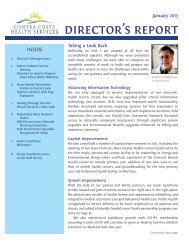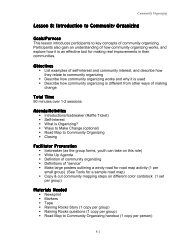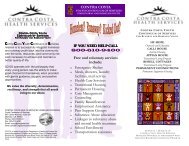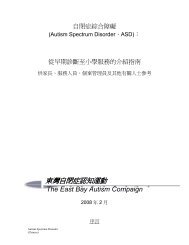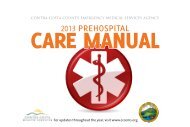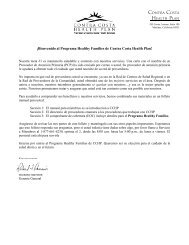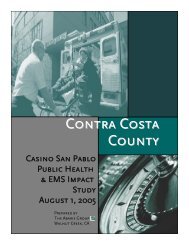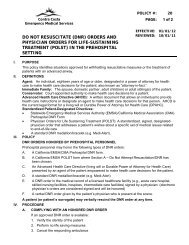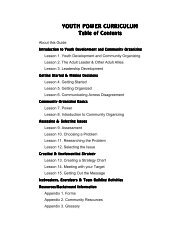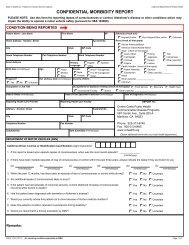EMS Policy Manual - Contra Costa Health Services
EMS Policy Manual - Contra Costa Health Services
EMS Policy Manual - Contra Costa Health Services
You also want an ePaper? Increase the reach of your titles
YUMPU automatically turns print PDFs into web optimized ePapers that Google loves.
<strong>Contra</strong> <strong>Costa</strong><br />
Emergency Medical <strong>Services</strong><br />
POLICY #: 31<br />
PAGE: 2 of 2<br />
o In the case where a patient has a physician-prescribed infusion device<br />
that is being controlled/monitored by either the patient or a family<br />
member.<br />
o In the event of cardiopulmonary arrest or extremis due to circulatory<br />
shock, and a peripheral IV or IO cannot be obtained, an indwelling<br />
central line(s) can be used by the paramedic to deliver fluids and<br />
medications within their scope.<br />
If any question exists, base contact should be made for further clarification.<br />
3. Central venous access devices that would require the penetration of skin by the<br />
paramedic, such as internal subcutaneous infusion ports or fistulas, may not be<br />
used.<br />
4. When handling a central line paramedics should:<br />
a. Use strict aseptic technique,<br />
b. Not remove injection caps from catheters,<br />
o Not allow IV fluids to run dry,<br />
o Always expel air from preloads/syringes prior to medication<br />
administration,<br />
o In the event of damage to the central line immediately clamp the external<br />
catheter between the site of the catheter damage and the patient.<br />
D. Thorascostomy Tubes<br />
Paramedics may monitor thorascotomy tubes.<br />
EMT-Is are not permitted to transport patients with thoracostomy tubes.<br />
E. Foley Catheters, Nasogastric Tubes, Gastrostomy Tubes, Tracheostomy Tubes<br />
EMT-I and paramedic personnel may transport these patients, however, these<br />
devices are not to be manipulated, removed, or discontinued.<br />
If any question exists, base contact should be made for further clarification.<br />
F. Home Ventilators<br />
EMT-Is may transport patients with home ventilators but these patients should ideally<br />
be transported via ALS-level ambulance.<br />
In an emergency situation requiring immediate transport (cardiac arrest, respiratory<br />
distress or extremis due to shock), patients may be transported to the closest facility<br />
via EMT-I ambulance and ventilation should be supported via bag-valve-mask device.<br />
G. Other Devices<br />
If other equipment is encountered by EMT-I or paramedic personnel, a patient may be<br />
transported with the equipment provided that the prehospital providers are not<br />
required to discontinue or alter the functioning of the equipment.<br />
If the patient cannot be moved without disrupting the function of the equipment, base<br />
consultation should be obtained.



